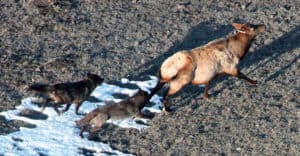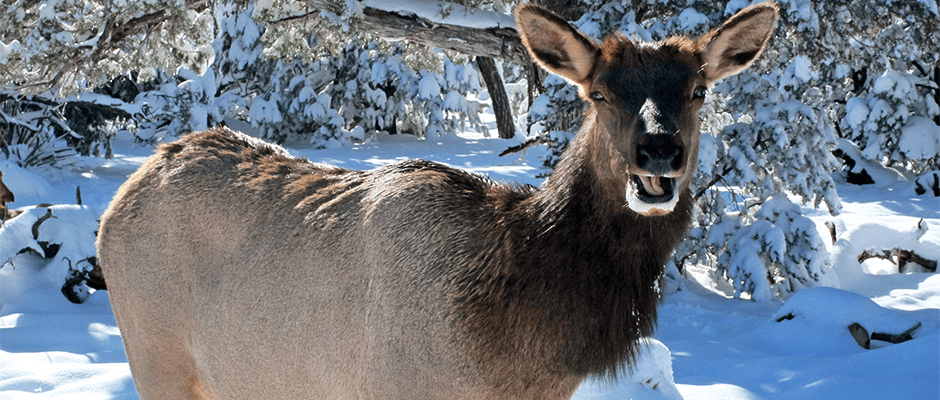Share this article
Wolves help shape how long elk keep antlers
In the late winter of 2005, TWS member Matt Metz started noticing a particular dynamic between elk (Cervus canadensis) and wolves (Canis lupus) in Yellowstone National Park, where he worked as a seasonal field technician for the Yellowstone Wolf Project.
Usually, bull elk shed their antlers beginning in mid-to-late March — later than any other North American cervid, and months after the rut, when the antlers served their role in battling competitors for cows to mate with. But the winter had been milder than usual, and elk were shedding their antlers early. By early March, some elk had already lost their antlers, and the wolves seemed to notice.
“Some of the first elk that the wolves had killed were elk that lost their antlers,” Metz said. “That struck me and my co-workers as odd.”

Wolves chase an elk that has shed its antlers in Yellowstone National Park. ©Doug Smith/NPS
Those early observations led to a study of over a decade’s worth of data that found an evolutionary tie between wolves and when elk shed their antlers. The longer the elk kept their antlers, researchers found, the better able they were to fend off wolves. Their findings were published in Nature Ecology & Evolution.
Elk antlers’ primary role is to fend off competitors for mating, but biologists have long suspected they may play a secondary role — as weapons to fend off predators, Metz said.
“I just don’t know that we’ve ever had the data to test it,” he said.
A TWS member and lead author of the paper, Metz was part of an unusual team that came together to research the topic, combing through 13 years’ worth of data. Metz is a longtime wolf biologist. His doctoral advisor at the University of Montana, TWS member Mark Hebblewhite, is an elk biologist. Doug Emlen, of the University of Montana, studies beetles and the evolution of animal weapons. Also on the team were Dan MacNulty, of Utah State University, and Dan Stahler and TWS member Doug Smith of the National Park Service, who brought to bear years’ worth of wolf research.
More than other cervids, elk are often a particular prey preference for wolves, Metz said. His team found that wolves tended to zero in on antlerless bull elk, even if they were fitter than those that hadn’t yet shed theirs. Keeping their antlers turned out to be an advantage, Metz said. “When they shed their antlers, it increases their risk of being killed.”
But keeping them longer comes at a cost. The earlier bulls shed their antlers, the earlier new antlers grow, meaning bigger antlers that can increase access to more cows to mate with.
Header Image: ©Michael Quinn/NPS








